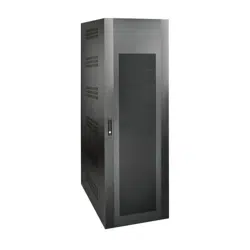Loading ...

2
Table of Contents
1. Introduction
1. Introduction 2
Features 2
2. Important Safety Instructions 3
Installation and Location Warnings 3
Connection Warnings 3
Battery Warnings 4
3. Battery Cabinet Installation 4
3.1 Preparation 4
3.2 Transportation 5
3.3 Mechanical Check 5
3.4 Internal Wiring (Typical) 5
3.5 Preliminary Electrical Check 5
(After Battery Installation)
3.6 Battery Cabinet Placement 5
3.7 Electrical Connection 6
3.8 Final Electrical Check 6
4. Operation and Charging 7
4.1 Determine Charging Voltages 7
4.2 Initial Charge 7
4.3 Operational Check 7
5. Maintenance 7
5.1 Maintenance Schedule 7
5.1.1 Quarterly Check 7
6. Mechanical Data 8
6.1 Physical Measurements 8
6.2 Battery Requirements 9
7. Installation 10
7.1 Battery Pre-Installation 10
7.2 Cable Jumpers and Internal Wiring 11
7.2.1 Included Cable Jumpers Specifications 11
7.2.2 Battery Cabinet Internal Wiring 12
7.2.3 Battery Cabinet Parallel Installation 13
7.3 Battery Installation 14
7.4 Installation Specifications 23
7.4.1 Installation and Floor Loading Information 23
7.4.2 Recommended Torque 23
8. Storage and Service 23
9. Warranty and Product Registration 24
Español 25
Русский 49
Tripp Lite’s Extended-Run Battery Cabinets connect to SmartOnline® UPS Systems to provide long-lasting battery backup for data centers,
telecommunications, networks, industrial facilities, security, emergency systems and other mission-critical applications that require high
capacity, high availability and extended runtime.
Features
• Battery cabinets are available in two options: BP480V370 and BP480V370NB. The BP480V370 model includes jumpers, terminals,
breaker, and 40 x of CSB GPL 121000 batteries in a separate pallet for a complete installation. The BP480V370NB model is a similar kit
but without batteries, allowing users the flexibility to purchase batteries for the cabinet separately.
• Battery cabinets are available in voltages of 480V DC and capacities option of 100Ah @ C20 to 1.67VPC.
• Battery cabinets contain multiple 12V DC batteries connected in series for higher voltages. Up to 3 battery cabinets may be connected in
parallel for increased runtime.
• Each battery cabinet contains 6 shelves with 5, 6, or 7 individual batteries (maximum) per shelf.
• Hinged lockable door facilitates access to batteries for periodic maintenance.
• A minimum of 130 mm clearance is located above the individual batteries for access to terminals.
• Battery cabinet is constructed of heavy gauge steel.
• Baked powder coat finish provides chip and corrosion resistance.
• Battery cabinet ships bolted to pallet with a double layer of protective stretch wrap and integrated corner and top protection.
• Appropriate ventilation and convection cooling of individual batteries is provided via spacing between batteries. Front and rear vents allow
the free flow of warmer air out of the battery cabinet.
• A molded case circuit breaker is provided for overcurrent protection.
• User-supplied power output cables can be fed into the battery cabinet via built-in conduit knockouts on top of the cabinet.
• For improved safety, higher power density and minimized maintenance, the cabinet systems use Valve-Regulated Lead-Acid (VRLA)
recombinant batteries. The electrolyte in these batteries is immobilized in either an absorbent mat separator or a gelling medium,
eliminating the spilling hazards and maintenance requirements of free liquid electrolyte. There is no need to add water or measure specific
gravity.
• Because the batteries are recombinant cells that employ an oxygen recombination cycle, minimal gasses are emitted during normal float
charging. Each cell contains an individual valve, which releases the gas products from overcharge and prevents pressure build-up within
the cell.
Loading ...
Loading ...
Loading ...
